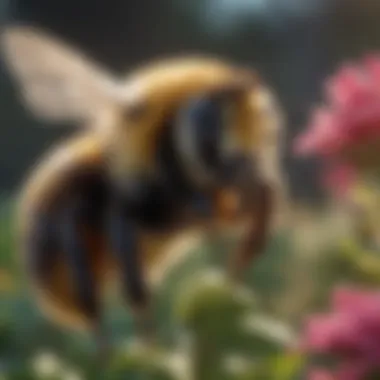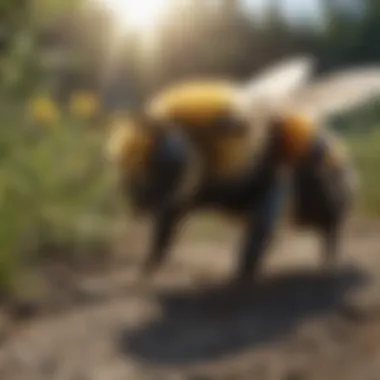Understanding Bumblebees: Strategies for Preservation


Intro
Bumblebees play a crucial role in many agricultural ecosystems. As effective pollinators, they contribute significantly to the productivity of numerous crops. However, bumblebee populations face various threats that jeopardize their survival. Understanding these challenges and ways to mitigate them is essential for sustaining both agricultural yields and biodiversity. This article aims to provide a comprehensive overview of bumblebee preservation. We will explore their behavior, habitat preferences, and specific strategies for coexistence with farming practices. By discussing these key elements, we hope to empower individuals and communities in fostering healthier agricultural environments that can support bumblebee populations.
Key Concepts and Terminology
Definition of Terms
Bumblebee: A large, fuzzy bee known for its robust body and effective pollination abilities.
Pollination: The transfer of pollen from male anthers to female stigma of plants, facilitating fertilization and fruit development.
Conservation: Efforts made to protect and preserve species and their habitats from extinction or degradation.
Habitat: The natural environment where bumblebees live, forage, and reproduce, crucial for their survival.
Overview of Relevant Practices
Bumblebee preservation involves several practices:
- Creating habitats that provide food and shelter.
- Reducing pesticide use to minimize harmful exposure.
- Planting native flowers that are attractive to bumblebees.
These efforts are essential in promoting healthy bumblebee populations, ensuring successful pollination, and enhancing overall agricultural productivity.
Current Trends and Innovations
Latest Research and Developments
Recent studies indicate declining bumblebee populations due to climate change and habitat loss. Research shows that warmer temperatures affect their foraging patterns. Scientists are investigating which species adapt well to changing climates, focusing on how to enhance their resilience.
Emerging Technologies and Tools
Innovations like drone technology are being utilized to monitor bumblebee habitats. These devices can map floral resources and identify critical areas needing protection. Data collected helps inform conservation strategies and policy decisions.
Practical Applications
Step-by-Step Guides
- Create a Pollinator-Friendly Garden:
- Participate in Local Conservation Programs:
- Educate Others:
- Choose native plants that bloom at different times.
- Avoid using chemical pesticides and herbicides.
- Join or support initiatives focused on habitat restoration.
- Collaborate with local farmers to create pollinator-friendly practices.
- Share information about bumblebee benefits and threats with community members.
- Encourage local schools to include pollinator education in their curriculum.
Troubleshooting Common Issues
- If plants are not attracting bumblebees, consider adjusting the types of flowers planted. Ensure there are enough nectar-producing varieties.
- If pest problems arise, explore natural pest control methods instead of insecticides.
Properly managing the agricultural landscape is essential not only for crop yield but also for the maintenance of vital bumblebee populations.
Prelims to Bumblebees
Bumblebees play a crucial role in the ecosystem, particularly in the realm of agriculture. They are essential pollinators that significantly contribute to the productivity of various crops. Understanding the biology, behavior, and social structure of bumblebees is vital for anyone involved in farming or horticulture. This section will elaborate on bumblebees' taxonomy, diverse species, and their complex life cycles, along with their behaviors that ensure their survival and productivity.
Taxonomy and Diversity of Bumblebees
Bumblebees belong to the genus Bombus, which is part of the family Apidae. This family includes other bees like honeybees and stingless bees. There are over 250 known species of bumblebees globally, exhibiting remarkable diversity in size, color, and behavior. Each species is adapted to thrive in specific habitats, which can range from temperate to polar climates.
The classification of these insects is based on various characteristics, including their physical traits and nesting habits. Some species, like the Bombus terrestris, are widely recognized due to their size and lack of distinct coloring, while others might be more elusive but equally important in certain ecosystems. Understanding this diversity is crucial for preservation efforts as different species face unique threats.
Life Cycle of Bumblebees
The life cycle of bumblebees is a fascinating process that involves several stages. It begins with the queen, who emerges from hibernation in early spring. After finding a suitable nesting site, she lays her first batch of eggs. These eggs hatch into larvae, which she feeds until they pupate and emerge as adult workers.
The lifecycle progresses as follows:


- Spring: Queen emerges from hibernation, lays eggs, and nurtures larvae.
- Summer: Worker bees take over foraging and nesting duties, gathering pollen and nectar to feed the growing brood.
- Autumn: New queens mate and seek shelter to hibernate, while the original colony dies off.
This cyclical nature of their lifecycle underlines the urgency in protecting bumblebee habitats as disruptions can threaten their survival.
Behavior and Social Structure
Bumblebee behavior is notable for its complexity and efficiency. Unlike solitary bees, bumblebees are social insects, forming colonies that can range anywhere from a dozen to several hundred individuals. The social structure is hierarchical, with a single queen at the top, followed by workers and new queens.
Foraging behavior is particularly interesting. Bumblebees use a technique called buzz pollination, which involves vibrating their bodies to release pollen from certain types of flowers. They are especially effective at pollinating crops like tomatoes and blueberries, enhancing agricultural yield.
Moreover, bumblebees exhibit strong territorial behavior, often defending their feeding areas from other foragers. This behavior is essential not only for their survival but also for maintaining the balance in their ecosystems.
"Bumblebees significantly enhance the biodiversity and productivity of agricultural systems, making their understanding essential for sustainable farming practices."
By studying bumblebees' taxonomy, lifecycle, and behavior, farmers and enthusiasts can develop informed strategies for promoting their preservation. Their involvement in agriculture cannot be understated. Recognizing and appreciating the importance of these pollinators will lead to better coexistence strategies in our ecosystems.
Role of Bumblebees in Agriculture
Bumblebees play a critical role in agriculture as significant pollinators, ensuring the reproductive success of many flowering plants. This section explores the multifaceted importance of bumblebees to agricultural ecosystems and outlines the various ways that these insects enhance farming practices. Understanding their contributions can help farmers and enthusiasts adopt better strategies for coexistence and preservation.
Pollination Mechanisms
Bumblebees have unique pollination mechanisms that are vital for the successful cultivation of numerous crops. Unlike solitary bees, bumblebees can perform a behavior known as buzz pollination. This process involves vibrating their bodies to release pollen from certain flowers, such as tomatoes and blueberries, making them particularly effective at ensuring pollination.
Bumblebees are also capable of visiting multiple types of flowers in one foraging trip. Their varied diet helps maintain biodiversity within agricultural settings. When they collect nectar and pollen from flowers, they simultaneously transfer pollen from one flower to another, facilitating cross-pollination. This process is essential for many crops, as it enhances the quality and quantity of fruit and seed produced.
Impact on Crop Yields
The direct link between bumblebee activity and crop yields is significant and well-documented. Crops that rely on bumblebee pollination tend to produce more abundant and higher-quality yields. Studies have shown that farms with healthy bumblebee populations often see a marked increase in production. For example, canola and fruit-bearing plants exhibit improved yield performance when bumblebees are present.
"The presence of diverse pollinators, including bumblebees, can increase crop yield by up to 50% in some instances."
This increase not only benefits individual farmers but contributes to food security on a larger scale. Understanding the role of bumblebees in boosting productivity provides a compelling rationale for their conservation.
Interactions with Other Pollinators
Bumblebees do not operate in isolation; they interact with a variety of other pollinators, such as honeybees and solitary bees. These interactions are crucial for creating a balanced ecosystem. A diverse pollinator community can enhance resilience against pests and diseases, ensuring that crops can thrive under varying environmental conditions.
Moreover, bumblebees can complement the efforts of other pollinators by visiting flowers that might be overlooked by honeybees due to size or floral structure. This synergy among different species maximizes pollination efficiency, ensuring that producers can maintain high productivity levels. Farmers should be aware of these relationships to cultivate pollinator-friendly environments that facilitate coexistence between bumblebees and other pollinators.
Threats to Bumblebee Populations
Bumblebees play a critical role in pollination, which is essential for agricultural productivity. However, several threats have emerged that jeopardize their populations. Understanding these threats is key to implementing effective preservation strategies. Addressing the challenges faced by bumblebees can help ensure their survival in our ecosystems and support agricultural practices.
Habitat Loss and Fragmentation
Habitat loss is one of the most significant threats to bumblebee populations. Urbanization and agricultural expansion often result in the destruction of wild habitats where bumblebees thrive. As natural landscapes are converted into cities or monoculture farms, bumblebees lose vital foraging grounds and nesting sites.
Fragmentation occurs when these habitats are broken up into smaller, isolated patches. This isolation makes it harder for bumblebees to find food and mates, which can lead to decreased genetic diversity. Without sufficient genetic variation, populations are less resilient to disease and environmental changes.
"Preserving larger, continuous habitats can significantly benefit bumblebee populations and their ability to sustain themselves."
Pesticide Exposure
Pesticides are widely used in agriculture to manage pests. However, many of these chemicals are harmful to bumblebees. Exposure to pesticides can lead to various negative effects, including impaired foraging behavior, reduced reproductive success, and even mortality.
Neonicotinoids, in particular, have raised concerns among scientists and conservationists. These systemic pesticides can affect bumblebees even at low exposure levels. Reducing pesticide use in favor of organic or less harmful alternatives can help protect these vital pollinators.
Climate Change Effects
Climate change poses complex challenges to bumblebee populations. As temperatures rise and weather patterns shift, bumblebees may find it difficult to adapt to these changes. Habitats may become unsuitable, and the timing of flowering plants could become mismatched with bumblebee activity.
The resulting pressure may force species to migrate towards more favorable climates. This shift can disrupt local ecosystems and lead to further declines in bumblebee populations. It is crucial to consider climate change in conservation discussions to back ecological resilience.
Disease and Parasites
Diseases and parasites represent another significant threat to bumblebee health. Emerging pathogens, such as Nosema and deformed wing virus, can devastate bumblebee colonies. Additionally, parasites like the Varroa mite can impact the bee population by weakening their hosts, making them more susceptible to diseases.


Monitoring and managing these threats through research and sound practices are essential to sustaining bumblebee health. Conservation efforts should include measures to reduce pathogen spread and protect bumblebee colonies from infected populations.
Conservation Strategies for Bumblebees
Conserving bumblebees is essential for maintaining a robust agricultural ecosystem, given their pivotal role in pollination. Effective conservation strategies not only support the well-being of bumblebee populations but also enhance crop productivity. Implementing targeted actions acknowledges the complex interplay between bumblebees, their habitats, and agricultural practices.
Adopting these approaches involves a comprehensive understanding of bumblebee needs and the environmental factors that affect their survival. It is crucial to recognize how conservation methods can simultaneously align with agricultural activities. As such, engaging farmers and land managers is essential for ensuring long-term success in bumblebee preservation.
Creating Bumblebee Habitats
Establishing suitable habitats is fundamental for the sustenance of bumblebees. Various elements are important in creating these environments:
- Flower Diversity: Bumblebees require a range of flowers that bloom throughout the growing season. This variety ensures a consistent source of nectar and pollen.
- Nest Sites: Providing areas for nesting can significantly enhance bumblebee populations. They favor sites such as grasslands, hedges, or even abandoned rodent burrows.
- Protection from Pesticides: Managing agricultural practices to limit pesticide exposure creates safer spaces for bumblebees to thrive.
These small changes can have substantial impacts. Agricultural areas can integrate flower strips or buffer zones with native flora that better attract bumblebees.
Promoting Native Flora
Native plants are crucial for supporting local bumblebee populations. These plants have co-evolved with bumblebees and provide the required food sources. By promoting native flora in agriculture, farmers can create environments better suited to insect pollinators. Some benefits include:
- Sustainability: Native plants require less maintenance and lower inputs of water and fertilizers compared to non-native species.
- Biodiversity: Enhanced plant diversity supports various insect species, promoting ecosystems that are resilient to changes.
Integrating native flora into agricultural systems aids in the overall health of the landscape. This synergy not only benefits bumblebees but also enhances soil quality and productivity.
Reducing Pesticide Use
Pesticides pose significant risks to bumblebee populations and other beneficial insects. Reducing their use can mitigate harm. Several strategies can be employed:
- Integrated Pest Management (IPM): This holistic approach emphasizes prevention and monitoring, using chemical controls only as a last resort.
- Selective Application: Targeted spraying during specific times when bumblebees are less active can limit exposure.
- Natural Alternatives: Exploring organic pesticides and biocontrol methods can minimize harmful impacts on pollinators.
Overall, reducing pesticide reliance fosters a more balanced ecosystem where bumblebees can flourish alongside crops.
Community Engagement and Education
Community involvement is vital in bumblebee conservation efforts. Engaging the public can increase awareness and foster supportive actions. Some effective methods include:
- Workshops and Events: Hosting local events can educate residents about the importance of bumblebees and conservation techniques.
- Volunteer Programs: Offering opportunities for community members to participate in habitat restoration projects encourages active participation and stewardship.
- School Programs: Integrating bumblebee conservation education in schools nurtures a sense of responsibility for younger generations.
Promoting collective action can create momentum towards establishing and maintaining thriving bumblebee populations.
Practical Steps for Individuals
Taking action on the individual level is crucial for the preservation of bumblebees. The choices made by each person can collectively lead to significant impacts on bumblebee populations and their habitats. Understanding the simple yet effective steps individuals can take not only empowers them but also contributes greatly to the broader goals of conservation and coexistence. These steps can range from gardening techniques to community engagement. Focusing on individual efforts can bridge the gap between ecological understanding and direct action, making a real difference in the health of agricultural ecosystems.
Gardening Techniques
Adopting specific gardening techniques encourages a thriving environment for bumblebees. Here are suggestions to consider when planning your garden:
- Native Plants: Use native flower species that provide food sources. Plants like Echinacea purpurea (purple coneflower) and Rudbeckia hirta (black-eyed Susan) are not only beautiful but also support local bumblebee populations.
- Diversity of Flowers: Plant flowers that bloom at different times throughout the growing season. This ensures that bumblebees have access to food during their active months. Aim to have early bloomers like crocuses and late bloomers such as asters.
- Avoid Neatness: Allow some wild areas or native plants to grow. Bumblebees are less attracted to overly manicured gardens. A more natural look often supports biodiversity and offers nesting areas for pollinators.
Gardening is a way to contribute directly to the habitat bumblebees need. Small changes can make a big difference in their survival.
Creating Pollinator-Friendly Spaces
Making spaces that are friendly to bumblebees is essential. Here are important considerations:
- Provide Nesting Sites: Bumblebees require specific nesting habitats, often in the ground or above ground in small cavities. Leaving patches of bare soil can provide essential nesting spots for ground-nesters.
- Minimize Pesticide Use: Chemicals can be harmful to bumblebees. Opt for organic methods or integrated pest management techniques instead of traditional pesticides. This will help preserve both bumblebees and other beneficial insects.
- Water Sources: Bumblebees, like all living creatures, need water. Creating shallow puddles or providing small water features in your garden can greatly assist them.
Overall, integrating elements that support bumblebees into your outdoor spaces encourages ecological health and diversity.
Participating in Citizen Science
Engaging in citizen science projects can enlighten both individuals and communities about bumblebee conservation. Here’s why it matters:
- Data Collection: Participating in projects helps gather essential data on bumblebee populations, behaviors, and distribution. Contributions may aid researchers and conservationists significantly.
- Awareness Raising: Being involved in citizen science increases awareness of bumblebee threats and conservation needs. Communicating findings to your network can spark interest and encourage further participation from others.
- Community Building: Joining local conservation groups or online platforms like Reddit can connect you with like-minded individuals. Sharing knowledge and experiences can foster a stronger community focused on resilience and sustainability.
By participating in such activities, individuals can expand their impact beyond personal gardens to influence broader initiatives.


Action Ability: Every small action taken can ripple out, creating larger waves of change for bumblebee populations.
Policy Recommendations for Bumblebee Protection
Bumblebees are essential to the environment and agricultural systems. Protecting these pollinators requires well-thought-out policies that can drive effective conservation strategies. The significance of policy recommendations extends beyond mere protection; they contribute to the public awareness and priority of bumblebee conservation among stakeholders.
These policies can create frameworks for habitat restoration, pesticide regulation, and public education initiatives focused on the importance of bumblebees in agriculture. The benefits are multifaceted. Strong policies can help streamline research funding, encourage sustainable agricultural practices, and promote community engagement in conservation efforts.
Legislative Frameworks
The establishment of robust legislative frameworks is crucial for the protection of bumblebee populations. These laws can regulate pesticide usage, protect vital habitats, and set guidelines for land use planning. By creating specific regulations aimed at reducing pesticide impacts, health of populations can see improvement.
Legislative measures could include the following:
- Restrictions on harmful pesticides: Ensuring that the most dangerous chemicals are banned or strictly controlled in agricultural regions can significantly reduce bumblebee mortality.
- Habitat protection laws: Policies that safeguard natural habitats from development and fragmentation are essential for maintaining bumblebee populations.
- Incentives for sustainable practices: Providing grants or subsidies to farms that adopt bee-friendly practices encourages wider participation.
Investment in regulatory agencies also plays a vital role. They must be equipped not just to enforce these laws but also to conduct ongoing research about bumblebee populations and their needs. Continuous monitoring can reveal the effectiveness of the policies in place and highlight areas in need of adjustment.
Funding for Research and Conservation
Funding is another key aspect of effective policy for bumblebee conservation. Comprehensive financial support for research is necessary to understand bumblebee ecology, their decline, and how to counteract these threats. Additionally, dedicated funds can assist local conservation groups in implementing on-the-ground projects that directly affect bumblebee habitats and populations.
The following avenues for funding can be explored:
- Government grants: National and local governments can allocate specific funds for pollinator research aimed at bumblebees.
- Collaboration with NGOs: Partnering with non-profit organizations can help pool resources and expertise, amplifying conservation efforts.
- Public-private partnerships: Engaging the private sector can bring in additional funding and innovative solutions for conserving bumblebee habitats.
"Investing in the preservation of bumblebees means securing the future of our agricultural systems and natural ecosystems."
Future Perspectives on Bumblebee Conservation
The conservation of bumblebees is vital for maintaining biodiversity and supporting agricultural health. As we look at future perspectives on bumblebee conservation, it becomes clear that innovative strategies and global collaboration are essential for sustaining their populations. Understanding the factors that aid in bumblebee conservation will help ensure these pollinators continue to thrive and support both ecosystems and agricultural productivity.
Innovative Research Approaches
Investing in innovative research approaches is crucial for enhancing our understanding of bumblebee behavior and ecology. This can include:
- Genomic Studies: Analyzing the genetic diversity of bumblebee species is key to understanding their resilience against threats.
- Behavioral Research: Observing bumblebee foraging patterns and social interactions can reveal the health of their populations.
- Habitat Monitoring: Utilizing technology like drones or remote sensing to explore bumblebee habitats helps in tracking changes in environmental conditions.
Research must also focus on developing effective conservation measures. Experimentation with habitat restoration techniques is needed to determine what will yield the best results for bumblebee populations. Understanding how landscape connectivity impacts bumblebee movement is another vital research area.
Global Initiatives and Collaborations
Addressing the challenges facing bumblebees requires global initiatives and collaborations. Numerous organizations and programs are focused on international bumblebee research and preservation efforts. Some key elements include:
- International Pollinator Initiative: A joint effort to assess and mitigate threats to pollinators.
- Bumblebee Conservation Trust: Engaging in habitat restoration and public education efforts on a global scale.
- Collaborative Projects: Universities and NGOs can partner to share data and develop effective strategies tailored to regional challenges.
Support from governments worldwide can enhance these efforts. Funding for research and conservation initiatives can stimulate understanding and commitment across nations. Multinational strategies will be essential in crafting sound policies that benefit both bumblebees and agriculture.
"The future of bumblebee conservation relies heavily on the collective efforts of scientists, policymakers, and communities alike. Together, we can create a sustainable environment that ensures the survival of these crucial pollinators."
Culmination
The conclusion serves as the final lens through which we view the importance of bumblebees in our ecosystems, particularly in agriculture. Bumblebees are crucial for the pollination of many crops, which directly impacts food production and biodiversity. Their decline would have significant consequences not only for agricultural productivity but also for the broader ecological balance.
Summary of Key Points
In summarizing the key points outlined throughout the article, it is clear that bumblebees face numerous threats, such as habitat loss, pesticide exposure, climate change, and disease. Addressing these issues involves implementing effective conservation strategies. These strategies include:
- Creating and preserving habitats conducive to bumblebee survival.
- Promoting native flora that provides food sources for bumblebees year-round.
- Reducing pesticide use to minimize harmful effects on these essential pollinators.
- Engaging communities in education and advocacy aimed at bumblebee protection.
This understanding leads to a more sustainable relationship between agriculture and natural ecosystems. By recognizing these factors, readers can appreciate the intricate connections between bumblebees and agricultural success.
Call to Action for Readers
As we conclude, a call to action stands before each reader. It is more than a mere suggestion; it is a responsibility. Everyone, from individual gardeners to policy-makers, has a role in this effort. Consider the following actions:
- Create Bee-Friendly Spaces: Plant native flowers and avoid monoculture planting. This increases the availability of diverse pollen for bumblebees.
- Participate in Local Initiatives: Get involved with local conservation groups or community gardens focused on protecting pollinators.
- Educate Others: Share knowledge about the importance of bumblebees with friends, family, and local communities.
- Advocate for Policies: Support legislation that aims to protect pollinators and their habitats.
Taking these steps can lead to a significant positive impact on bumblebee populations. Such collective actions contribute to ensuring future generations can also enjoy the benefits that bumblebees bring to our environment and agriculture.
"Collective action is essential to safeguard the delicate balance of nature. Every small effort counts."
The future of bumblebees rests not only on awareness but on active participation. The time to act is now.







